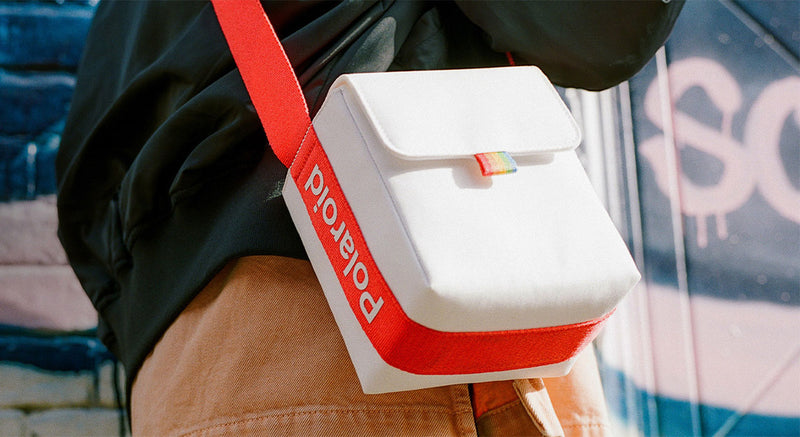

Summer is the best time for instant photography–the light, the vibe, the people... Everyone wants to capture those breezy, dreamy summer memories and cherish them for years to come. But for the best photo results, we’ve got a couple tips to really elevate your game.
Be ready for wherever a summer’s day takes you, with our guide to getting those Polaroid photographs you’ll always treasure.

Tip one: Keep it cool.
Polaroid film loves summer: longer days with plenty of natural light, sun-drenched afternoons at the beach, and gorgeous golden hour moments. When you’re soaking up the sun, it’s easy to forget that Polaroid film is a bit more sensitive to the heat than we are. By taking care to keep your film and Polaroid camera cool, you can be sure you’ll get better and more consistent results.
Polaroid film is best stored in the fridge to keep the film chemistry stable. When you’re ready to use it, take it out of the fridge and let it sit for an hour or so to adjust to room temperature.
We designed the Polaroid film box with intention: it helps to protect each film pack from light and moisture damage. As a result, we always recommend keeping unused film sealed inside of its unopened box, in a cool and dry environment until you are ready to shoot with it. But don’t put it in the freezer! That’s too cold.

Tip two: More temp tips.
Polaroid pictures develop best between 55-82 °F (13-28 °C), so if you’re planning a long day out in the sun, keep your film out of the heat until you’re ready to shoot–we like to use a cooler bag with a few ice packs inside–and keep your shots face-down away from any bright light or warm rays as they develop.
Translation missing: en.Above 82°F (28°C), color photos will have a tendency to develop with a yellow/red tint. When shooting at higher temperatures, minimize the effect of heat by letting your photos develop in cooler surroundings, like an air-conditioned room, an insulated bag, or beneath a cold beverage

Tip three: Let the sun shine, strategically.
Make the most of the “golden hour”—that sweet spot shortly after sunrise and before sunset. This is when the sun casts a golden glow over your subjects to give you photos full of color and contrast. If you’re more of a midday-riser, make sure the sun is behind you when you’re taking a photo so that your subject is flooded with light.

Tip four: Develop in the dark.
If you’ve ever shot instant film, you’ve probably heard it before: shield your photos from light! Polaroid film is sensitive to light even after it has been ejected from the camera. During these sensitive first few seconds, the film shield installed on your camera will extend on top of the photo and protect it from light.
After the first few seconds have passed, you can remove the photo from under the film shield. Your photo is still sensitive to light though, so keep it somewhere dark and dry until the development time has passed (check the back of your film pack for exact times). Per our earlier tips, if it’s hot outside, opt for somewhere cooler like an insulated bag, a shady spot, or facedown under a cool beverage.
Protecting your photo from the summer sunshine is actually what will ensure that you get deeper saturation and sharper details.
Tip five: Shield it, don’t shake it.
No matter how catchy the tune is, don’t shake your photos. It can damage the development!

Tip six: Dos and don’ts of flying with film.
Stocking up on film before a flight? Remember: Keep your camera and film in your carry-on bag. When you get to security, ask to have your camera and film checked by hand—don’t send them through the X-ray machine. These machines cause a reaction in the film which ruins the color. Film that goes through the X-ray machine usually turns out cloudy and pink. Photos you have already taken (also known as exposed film) are completely unaffected by X-rays, so they will be safe in any baggage.
Tip seven: Safely store your photos.
Even after your photo has developed, there are still tiny chemical reactions happening under the surface, so it’s important to protect your photos from light for a while. To ensure your photos last longer, store them somewhere, safe, dry, and dark for the first 30 days. Photo boxes, or even a good old shoe box work great.
Translation missing: en.After the first 30 days have passed, your photos can happily live in a <a href="/products/polaroid-photo-album">photo album</a>, or even framed. But if you do frame your photos, make sure the glass is UV protective, otherwise the light will fade the photo over time.
summer collection.
In the meantime, keep your film cool, maximize the sun in the shot, but protect your photos from the sun after the shot, while it’s developing make sure it’s not too hot, avoid X-rays when you travel, and lastly, store your photos safely. Still feeling unsure about how to protect your instant film? Find our quick X-ray guide to prepare for your travels here. We can’t wait to see what you’ll capture this summer and beyond.